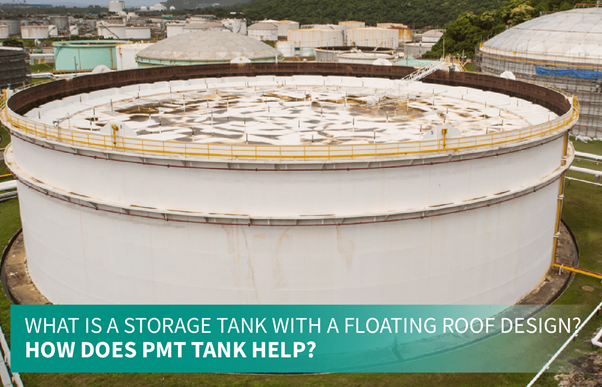What is a storage tank with a Floating Roof Design?
How does PMT Tank help?

The floating roof of a storage tank is a critical part that helps reduce emissions, stop evaporation, and maintain the quality of the things being stored. Storage tanks are crucial for several industries, such as oil and gas, chemical production, and water treatment. Still, it can be hard to design and build a storage tank, especially if it has to have a floating roof.
A floating roof must be carefully designed, and correct calculations require robust software.
In this blog, we'll talk about how software can speed up the design of storage tanks, saving time and money while ensuring the tank's effectiveness and safety. The advantages of each type of floating roof design calculation will also be covered.
What is a floating roof storage tank:
- A storage tank to hold several liquids, including crude oil, gasoline, and chemicals, needs a floating roof storage tank. Unlike fixed roof tanks, floating roof tanks have a roof that floats and moves up and down with the level of liquid inside the tank, forming a seal that stops vapours from escaping into the atmosphere.
- There are three primary types of floating roof designs for storage tanks. The kind chosen is determined by the type of liquid stored and its flash point.
External Floating Roof:
- In this design, the roof floats on top of the liquid surface and is not attached to the tank's shell. Large amounts of low flashpoint liquids, such as gasoline and crude oil, are frequently stored using this design. The roof is equipped with a rim seal system that prevents the escape of vapours and reduces emissions. The rim seal system consists of a flexible sealing material that is placed between the roof and the tank shell.
- Enhanced safety due to fewer emissions and evaporation
- Less product loss
- Simple maintenance due to the floating roof's accessibility
Open Floating Roof:
- The simplest sort of floating roof design, known as an "Open Floating Roof," is frequently applied to items with low flashpoints. The design has only one deck and no fixed roof, which leaves the product being stored exposed to the environment and enables the liquid to be stored to become contaminated. The IFR rests on the surface of the stored liquid and moves up and down with changes in the liquid level. It is supported by a series of buoyancy pontoons and is equipped with a rim seal system, similar to the external floating roof, to prevent the escape of vapours and reduce emissions.
- It is economical
- Less evaporation and emissions, thanks to the design.
- Simple upkeep because there is no permanent roof
Pontoon-style Floating Roof:
- With this construction, the floating roof is made up of a number of sealed pontoons that float on the water's surface. For storing liquids with a high flashpoint, like heavy fuel oils, this design is frequently utilised. It is a type of floating roof tank design that uses a series of individual pontoons or tubes to provide buoyancy and support the roof.
- Enhanced safety due to fewer emissions and evaporation
- Enhanced product stability
- Simple maintenance due to the floating roof's accessibility
Advantages of a floating roof:
- The main advantage of a floating roof storage tank is its capacity to reduce evaporative losses of the stored liquid, which results in significant cost savings. By removing the space between the surface of the liquid and the roof of the tank, the floating roof tank reduces the amount of vapour that can escape into the atmosphere, reducing evaporative losses and producing significant cost savings.
- Emissions of volatile organic compounds (VOCs), which can have detrimental impacts on the environment and human health, are also decreased.
The advantages of software for designing storage tanks:
- The effectiveness of the project can be significantly impacted by the design software used while creating a storage tank. Many advantages that increase the effectiveness and accuracy of the design process are offered by advanced floating roof design software, including:
Collaboration and Communication that is Simplified:
- A storage tank's design is frequently a collaborative endeavour involving multiple persons. Team members can work together in real-time using cutting-edge software for designing floating roofs, which streamlines and effectively facilitates communication. As a result, there are fewer chances of mistakes and misunderstandings because everyone is on the same page.
Friendly User Interface:
- The user-friendly interface of the PMT Tank Storage Tank design software makes it simple for users to explore and comprehend the programme. This feature makes learning about tank design easier, which is very helpful for beginners.
Reliable Estimates: Storage
- The capacity of sophisticated floating roof design software to perform precise calculations is one of its most important advantages. This programme gives designers the resources they need to make wise design choices, ensuring that the storage tank complies with all legal and regulatory criteria.
Conclusion:
- In conclusion, much thought must go into the construction of a storage tank, especially when choosing the ideal floating roof design. Sophisticated floating roof design software gives users the resources they need to make well-informed design choices, ensuring that the storage tank complies with all applicable laws and regulations.
